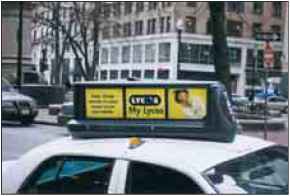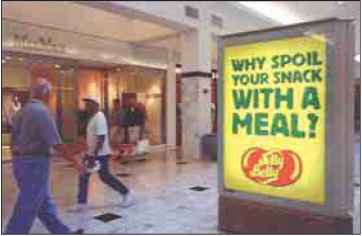Transit Advertising
Another form of out-of-home advertising is transit advertising. While similar to outdoor in the sense that it uses billboards and electronic messages, transit is targeted at the millions of people who are exposed to commercial transportation facilities, including buses, taxis, commuter trains, elevators, trolleys, airplanes, and subways.
Transit advertising has been around for a long time, but recent years have seen a renewed interest in this medium. Due in part to the increased number of women in the work force (they can be reached on their way to work more easily than at home), audience segmentation, and the rising cost of TV advertising, yearly transit ad spending increased from $43 million in 1972 to over $900 million in 2001.10 Much of this spending has come from packaged-goods companies such as Colgate, Nestlé, Kraft-General Foods, America Online, and Lycos, which like transit's lower costs and improved frequency of exposures. Other retailers, movie studios, and business-to-business companies have also increased expenditures in this area (Exhibit 13-7).
Exhibit 13-7 The FBI uses outdoor to recruit

Types of Transit Advertising There are actually three forms of transit advertising: (1) inside cards, (2) outside posters, and (3) station, platform, or terminal posters.
Inside Cards If you have ever ridden a commuter bus, you have probably noticed the inside cards placed above the seats and luggage area advertising restaurants, TV or radio stations, or a myriad of other products and services. An innovation is the electronic message boards that carry current advertising information. The ability to change the message and the visibility provide the advertiser with a more attention-getting medium.
Transit cards can be controversial. For example, in the New York subway system, many of the ads for chewing gum, soup, and Smokey the Bear have given way to public service announcements about AIDS, unwanted pregnancies, rape, and infant mor- outside posters often tality. While subway riders may agree that such issues are important, many of them appear on taxicabs complain that the ads are depressing and intrusive.
Outside Posters Advertisers use various forms of outdoor transit posters to promote products and services. These outside posters may appear on the sides, backs, and/or roofs of buses, taxis, trains, and subway and trolley cars.
The increasing sophistication of this medium is demonstrated by a new technology, developed by Vert, Inc., a small company in Boston, that transforms ads on top of taxi-cabs into real-time animated electronic billboards. Available in New York and Boston, a web server that communicates with a global positioning satellite (GPS) is built into the taxi-top screen. The GPS determines the taxi's location and sends it to the local server, which then delivers the relevant ads for a particular area. A taxi traveling through a Hispanic community can have a message in Spanish, stock quotes could appear in the financial district, and so on. The ads appear in color in a format similar to banner ads, at 10 times the brightness of a TV screen. Space is sold in blocks of time, with cost dependent on the neighborhood, usually ranging from $1 to $5 CPM.11 (See Exhibit 13-8.)
Station, Platform, and Terminal Posters Floor displays, island showcases, electronic signs, and other forms of advertising that appear in train or subway stations, airline terminals, and the like are all forms of transit advertising. As Exhibit 13-9 shows, terminal posters can be very attractive and attention-getting. Bus shelters often provide the advertiser with expanded coverage where other outdoor boards may be restricted. Gannett Transit recently introduced electronic signs on subway platforms in New York.

- Exhibit 13-8 Electronic

Exhibit 13-9 Terminal posters can be used to attract attention
Continue reading here: Advantages and Disadvantages of Transit Advertising
Was this article helpful?